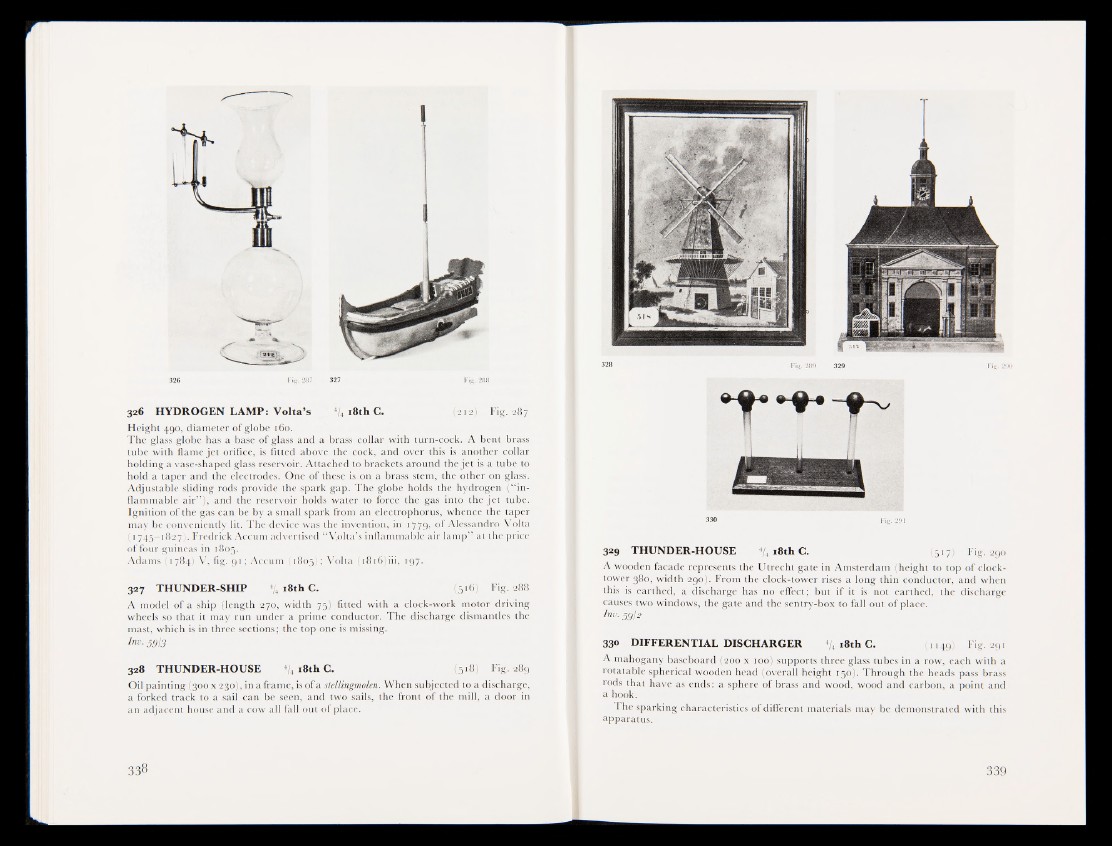
I
326 HYDROGEN LAMP: Volta’s 4/4 18th C. (212) Fig. 287
Height 490, diameter of globe 160.
The glass globe has a base of glass and a brass collar with turn-cock. A bent brass
tube with flame jet orifice, is fitted above the cock, and over this is another collar
holding a vase-shaped glass reservoir. Attached to brackets around the jet is a tube to
hold a taper and the electrodes. One of these is on a brass stem, the other on glass.
Adjustable sliding rods provide the spark gap. The globe holds* the hydrogen win-
flammable air” ), and the reservoir holds water to force the gas into the jet tube.
Ignition of the gas can be by a small spark from an electrophorus, whence the taper
may be conveniently lit. The device was the invention, in iStgj, of Alessandro Volta
(1745—1827). Fredrick Accum advertised “V.olta’s inflammable air lamp” at the price
of four guineas in 1805.
Adams (1784) V, fig. gi; Accum (1805)5 Volta (1816)iii, 197-
327 THUNDER-SHIP 4/4 18th C. (^■ 516) Fig. .288
A model of a ship (length 270, width 75) fitted with a clock-work motor driving
wheels so that it may run under a prime conductor. The discharge dismantles the
mast, which is in three sections; the top one is missing.
Inv. 59I3
328 THUNDER-HOUSE 4/4 18th C. ;M;|i8) Fig. 289
Oil painting (300 x 230), in a frame, is of a stellingmolen. When subjected to a discharge,
a forked track to a sail can be seen, and two sails, the front of the mill, a door in
an adjacent house and a cow all fall out of place.
330 Fig. 291
329 THUNDER-HOUSE 4/4 18th C. (517) Fig. 290
A wooden facade represents the Utrecht gate in Amsterdam (height to top of clock-
tower 380, width 290). From the clock-tower rises a long thin conductor, and when
this is earthed, a discharge has no effect; but if it is not earthed, the discharge
causes two windows, the gate and the sentry-box to fall out of place.
Inv. ;-)9i2
330 DIFFERENTIAL DISCHARGER 4/4 18th C. (1 14 9 ) Fig. 291
A mahogany baseboard (200 x 100) Supports three glass tubes in a row, each with a
rotatable spherical wooden head (overall height 150). Through the heads pass brass
rods that have as ends: a sphere of brass and wood, wood and carbon, a point and
a hook.
The sparking characteristics of different materials may be demonstrated with this
apparatus.